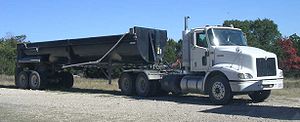 Image via Wikipedia18 Wheeler Dangers:
Image via Wikipedia18 Wheeler Dangers: The size of a tractor-trailer means that they handle much differently than a passenger vehicle. One of the biggest differences is stopping distance. At 65 mph, a car requires approximately 160 feet to stop. A semi-truck, on the other hand, needs approximately 420 feet to stop.
A big rig also has huge blind spots, commonly referred to as "no zone" areas. We are all used to the blind spot in our own car, but trucks have multiple blind spots, including in the front and the back. This makes it difficult for the driver to spot surrounding vehicles, which could lead to a collision.
In addition, semi-trucks make wide turns. A driver often has to swing in the opposite direction before negotiating a turn. For example, before making a right turn, a tractor-trailer driver may first swing the truck left to accommodate the wide turning radius. This can endanger vehicles on either side of the truck.
The height and weight distribution of an 18-wheeler makes it particularly susceptible to rollovers. Although often caused by speeding, truck rollovers can occur even at very low speeds, especially when going around corners and up or down a steep pitch. Rollovers may also occur when a tire goes off the pavement and a driver tries to return the semi-truck to the road.
Driver Error
Aside from the physical limitations of 18-wheelers, other factors can lead to truck accidents. Although truck drivers by and large are skilled, attentive, courteous drivers, even minor lapses in judgment on their part can lead to a catastrophic situation. Actions such as speeding, tailgating, swerving, failing to signal, and driving under the influence of drugs or alcohol can all lead to a truck accident.There are also a number of factors inherent to the trucking business that can lead to a big rig accident. Truck drivers often operate within a system of compensation that encourages driving faster and for more consecutive hours than is safe. They may also drive through hazardous conditions in order to meet deadlines. Additionally, drivers may receive inadequate training that does not prepare them for the danger of driving a tractor-trailer.
